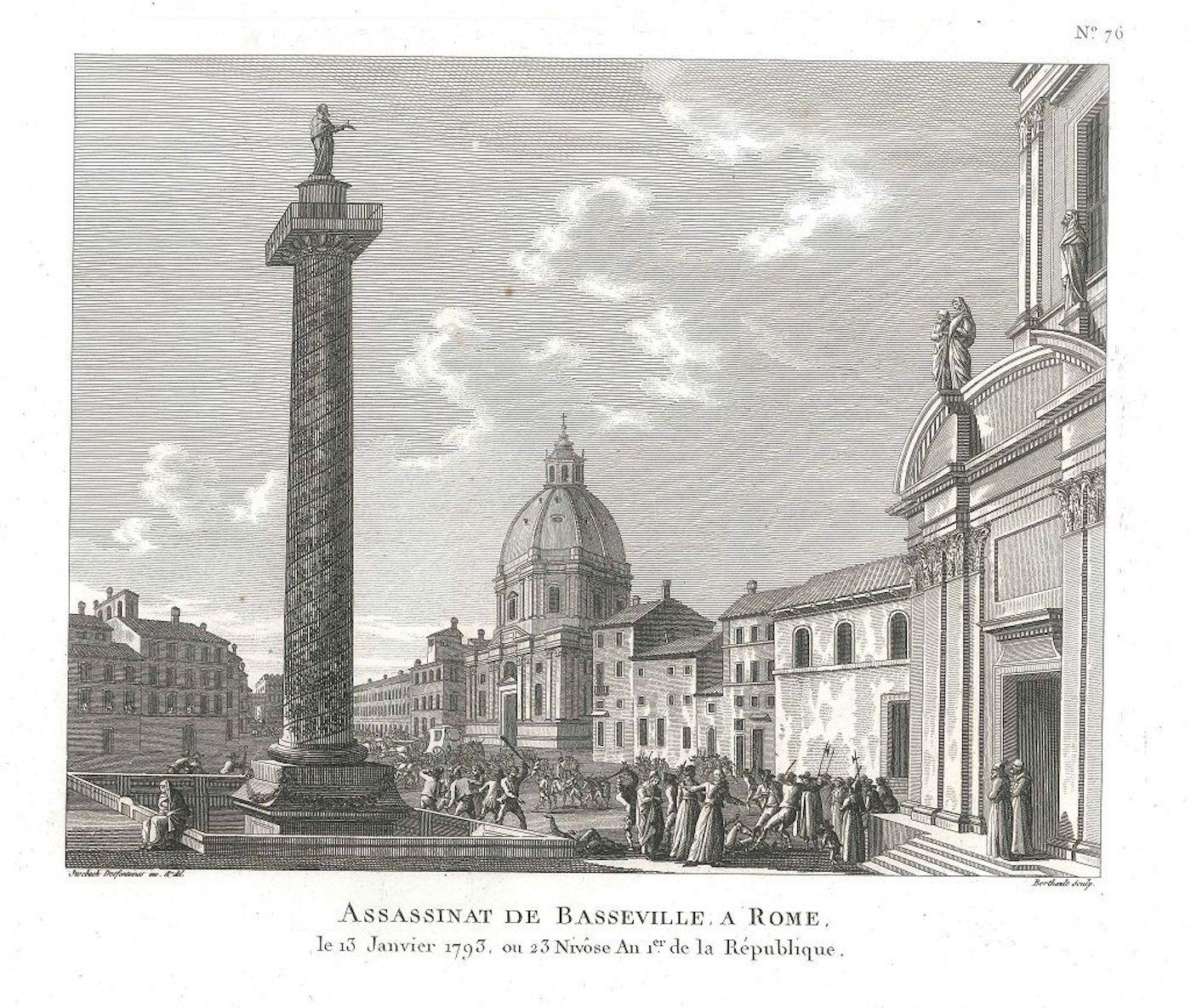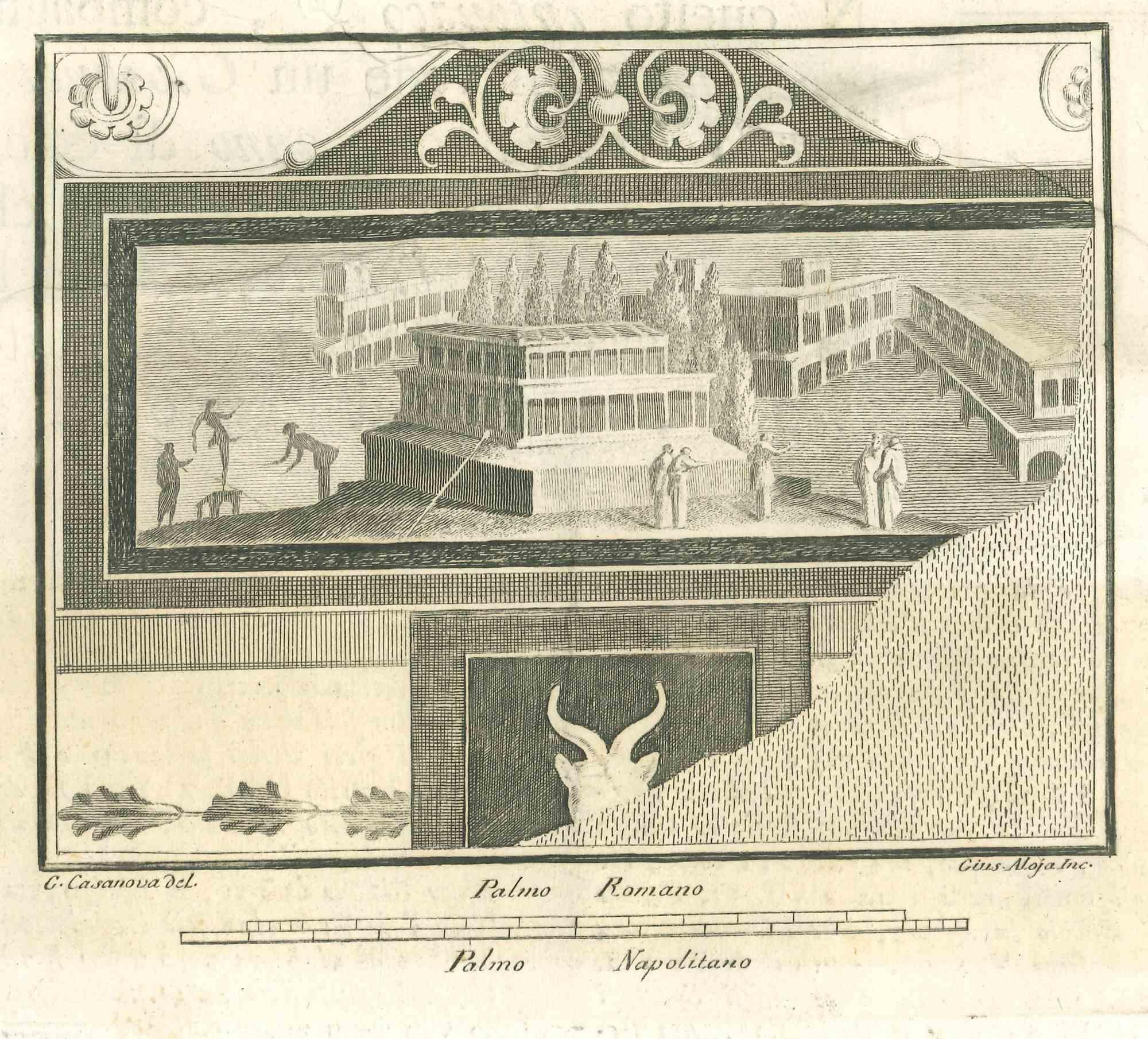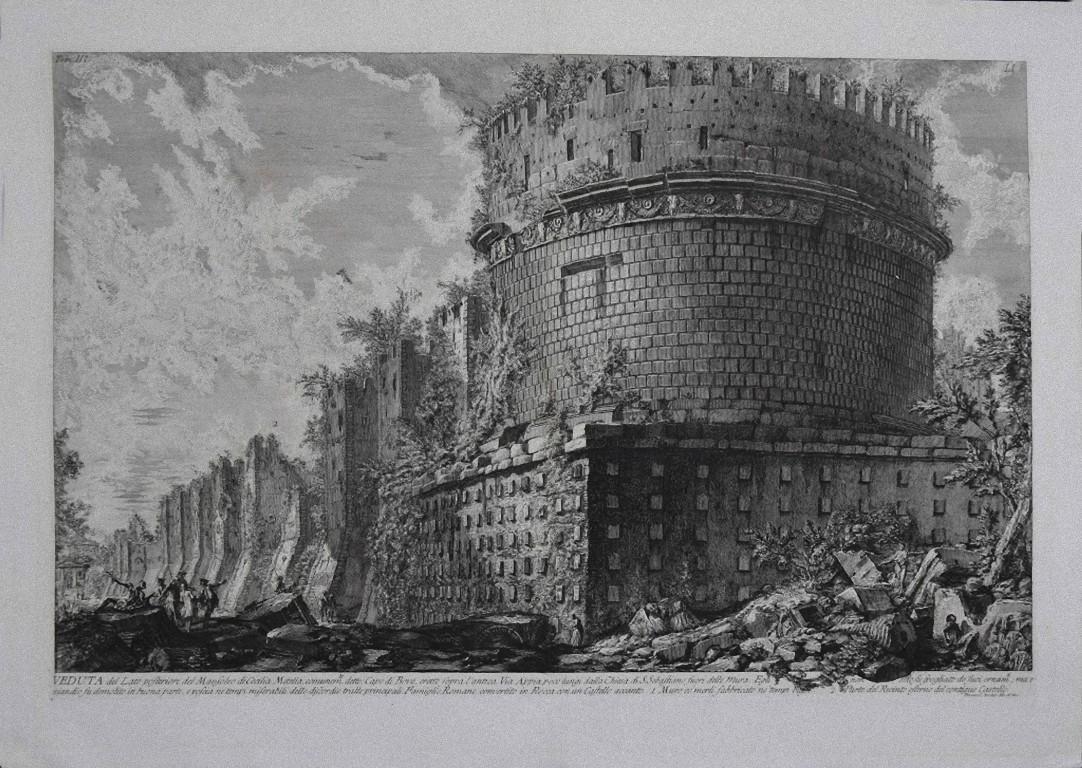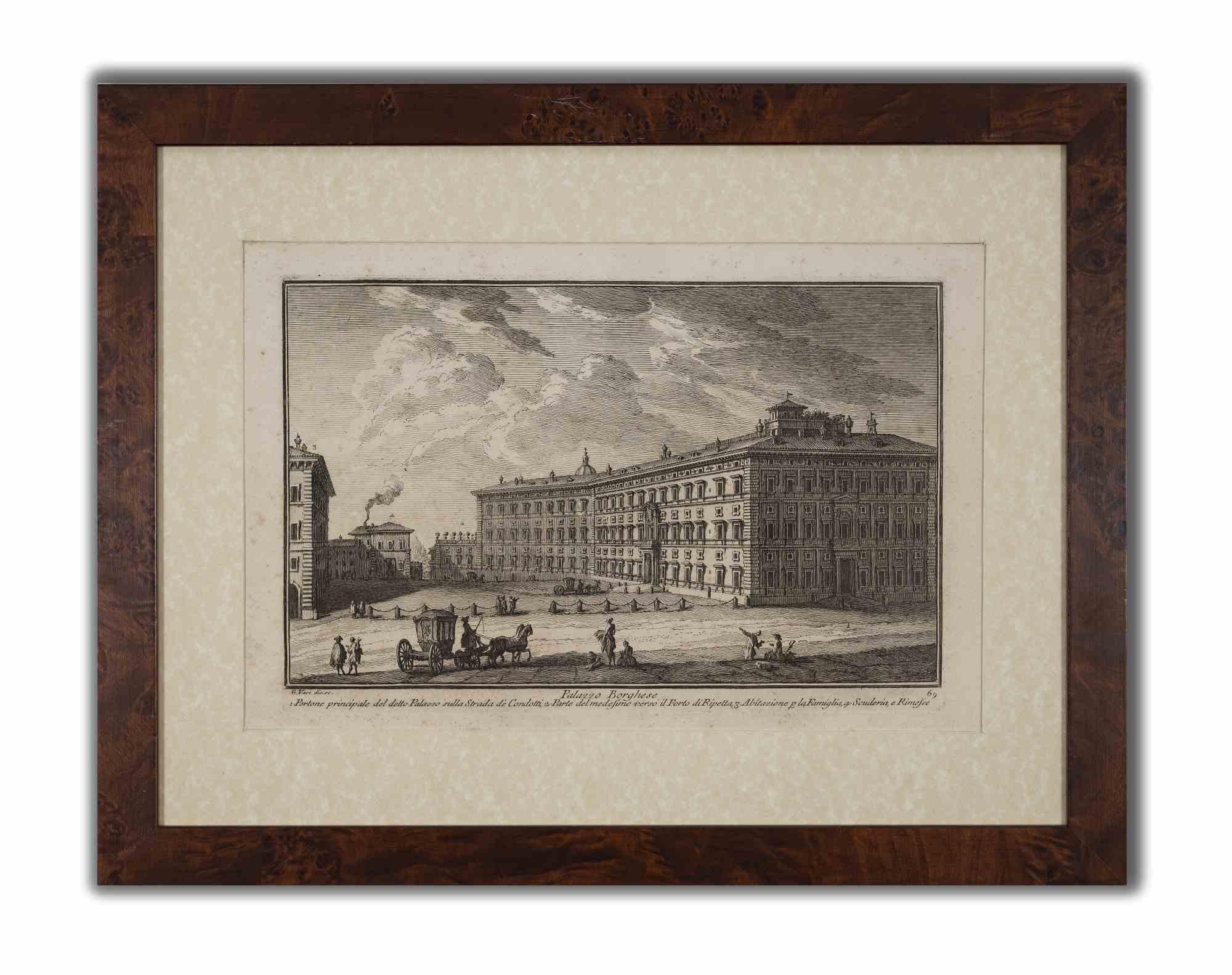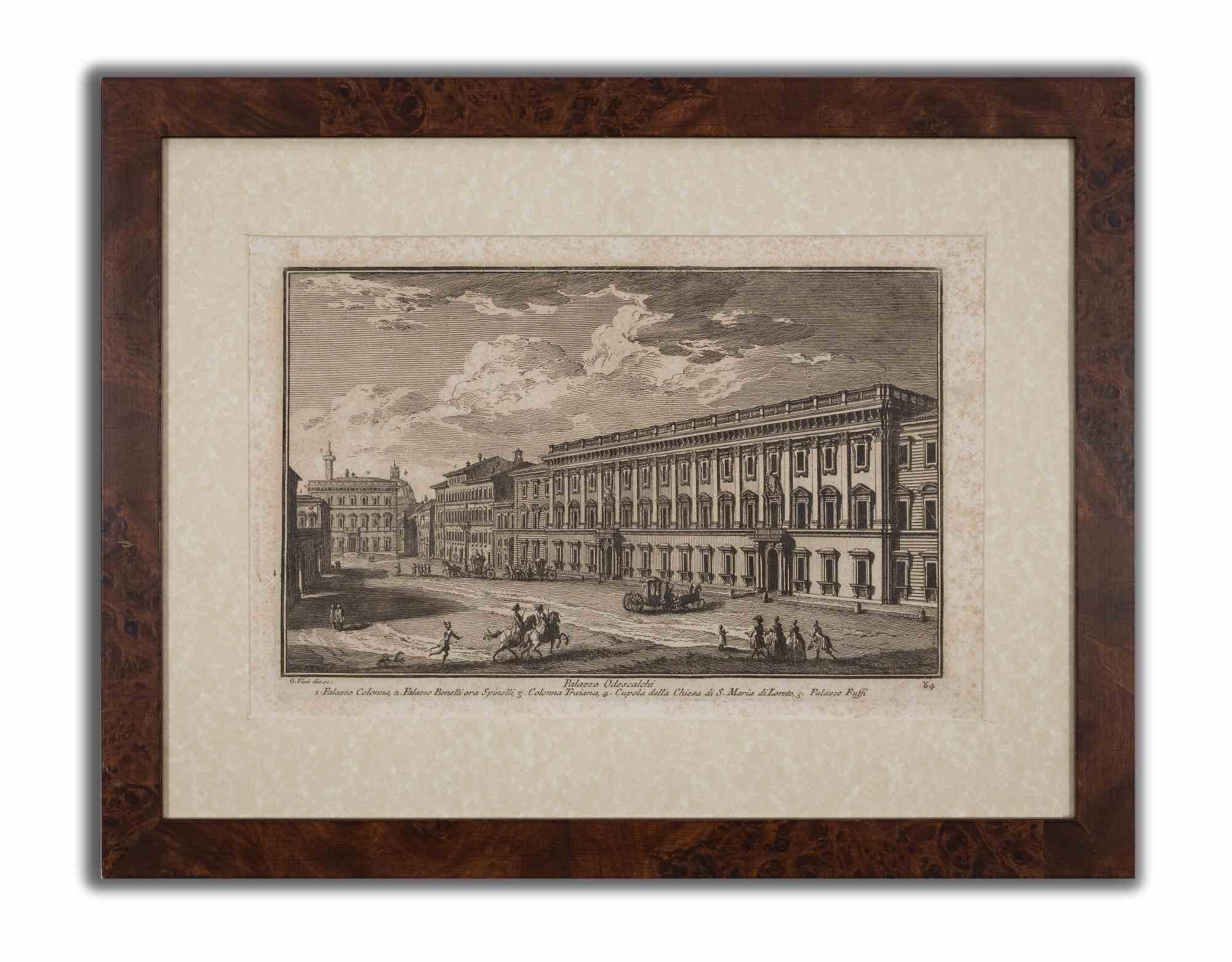Items Similar to Seascape With Monuments - Etching by Raffaele Barone - 18th Century
Want more images or videos?
Request additional images or videos from the seller
1 of 2
Raffaele BaroneSeascape With Monuments - Etching by Raffaele Barone - 18th CenturyLate 18th Century
Late 18th Century
About the Item
Seascape With Monuments is an Etching realized by Raffaele Barone (18th Century).
The etching belongs to the print suite “Antiquities of Herculaneum Exposed” (original title: “Le Antichità di Ercolano Esposte”), an eight-volume volume of engravings of the finds from the excavation of the ruins of Herculaneum in the Kingdom of Naples (now Campania, Italy).
It was published between 1757 and 1792 by the Regia Stamperia, and copies were delivered to selected recipients across Europe.
Despite the title, the Antiquity of Herculaneum shows objects from all the excavations undertaken by the Bourbons in the Gulf of Naples. These include Pompeii, Stabia and two sites of Herculaneum: Resina and Portici.
The Bourbon King Carlo appointed fifteen scholars creating a new “Herculaneum Academy” to study the artifacts and publish the results of the archaeological excavations of the sites.
The engravings are of high quality and the accompanying text shows a large scholarship.
They were realized by 25 prominent artists involved by the King to prepare drawings and engravings on the finds, among which we can find Giovanni Elia Morghen, Carlo Nolli, Luigi Vanvitelli and Giovanni Battista Casanova.
The “Antiquities” was designed more to amaze readers with the quality of the objects in the collection of the King of Naples than to be used in research., following and increasing the interest of 18th century society for the classical culture and Art in particular.
Through the exaltation of the classical concept of proportions and harmony, the book was of inspiration to the neoclassical movement in Europe, giving artists and decorators access to a huge shop of Hellenistic motifs.
Ref.:
National Gallery (Washington), Mark J. Millard Architectural, IV (2000), no. 1;
L. Garcia y Garcia, Nova bibliotheca pompeiana (2 v., 1998);
Royal Institute of British Architects, British Architectural Library ... Early printed books, 1 (1994), no. 112.
U. Pannuti, 'Incisori e disegnatori della Stamperia Reale di Napoli nel secolo XVIII: la pubblicazione delle Antichità di Ercolano', in Xenia antiqua, 9 (2000), p. 151-178;
V. Trombetta, 'L'edizione de Le Antichità di Ercolano esposte' in Rendiconti dell'Accademia di Archeologia, lettere e belle arti di Napoli , 59 (1984), p.151-172.
- Creator:Raffaele Barone
- Creation Year:Late 18th Century
- Dimensions:Height: 4.53 in (11.5 cm)Width: 9.06 in (23 cm)Depth: 0.04 in (1 mm)
- Medium:
- Movement & Style:
- Period:
- Framing:Framing Options Available
- Condition:Insurance may be requested by customers as additional service, contact us for more information.
- Gallery Location:Roma, IT
- Reference Number:
About the Seller
4.9
Platinum Seller
These expertly vetted sellers are 1stDibs' most experienced sellers and are rated highest by our customers.
1stDibs seller since 2017
6,822 sales on 1stDibs
Typical response time: 3 hours
- ShippingRetrieving quote...Ships From: Grasse, France
- Return PolicyA return for this item may be initiated within 14 days of delivery.
More From This SellerView All
- Assassinat de Basseville à Rome - Original Etching by P.G. Berthault - 1793By Pierre Gabriel BerthaultLocated in Roma, ITAssassinat De Basseville à Rome is an original black and white etching realized by Pierre Gabriel Berthault, after Jacques François Joseph Swebach-Desfontaines in 1793. Title with caption on plate on the lower center: "Assassinat de Basseville, à Rome/ le 13 Janvier 1793, ou 23 Nivose An Ier de la République". Below the image on the lower margin, "Swebach Desfontaines onv. et del. / Berthault sculp." is etched on plate. This modern artwork is numbered "N. 76", because it is from the series Les Tableaux historiques de la Révolution française. As a matter of fact, Pierre-Gabriel Berthault is well-known for having engraved plates from this collection with the collaboration of the engraver Jean Duplessis-Bertaux. A work - hanging in the balance between news and history - with illustrations of salient or minimal events occurred during the French Revolution. As a celebration of the new ideals of brotherhood, justice, and equality, Les Tableaux immediately became a point of reference for journalism at the time. Of traditional cut, namely showing a view with many human figures, the engraving simplified the lines to be immediately readable for the general public. In our specific case, this original print represents the murder of Hugou de Bassville or Basseville (7 February, 1743 – 13 January, 1793), a French journalist and diplomatist, and protector of the radical Jacobins in Rome. In excellent conditions, except for a usual yellowing of the paper on the edges and a light trace of oxidations on the lower and right margins, beyond the marginal line of the matrix. Pierre-Gabriel Berthault (Saint-Maur-des-Fossés, 1737 - Paris, 1831) was a French master who made engravings from drawings by Jean-Claude Richard de Saint-Non (known as the Abbot of Saint-Non) and from paintings by Louis François Cassas. He depicted many views of Italy and created the collections Voyage à Naples and Voyage pittoresque de la Syrie, de la Palestine et de la basse-Egypte. Before the French Revolution, he was famous for being the author of the Vues intérieures de Paris and for tables with architectural elevations.Category
1790s Old Masters Landscape Prints
MaterialsEtching
- Seascapes With Monument and Figures - Etching by Giuseppe Aloja - 18th CenturyLocated in Roma, ITSeascapes With Monument and Figures is an Etching realized by Giuseppe Aloja (1783-1837). The etching belongs to the print suite “Antiquities of Herculaneum Exposed” (original titl...Category
18th Century Old Masters Figurative Prints
MaterialsEtching
- View of Mausoleo of Cecilia Metella - Etching by G. B. Piranesi - 1773By Giovanni Battista PiranesiLocated in Roma, ITView of Mausoleo of Cecilia Metella is an original etching realized by the italian artist Giovanni Battista Piranesi in 1773. Precoius roman edition. Complete title on the lower ma...Category
1770s Old Masters Figurative Prints
MaterialsEtching
- Palazzo Borghese - Etching by Giuseppe Vasi - 1747By Giuseppe VasiLocated in Roma, ITPalazzo Borghese is original black and white etching realized by Giuseppe Vasi . Beautiful etching representing Palazzo Borghese in Rome. Signed and...Category
Mid-18th Century Old Masters Figurative Prints
MaterialsEtching
- Interno della Basilica della Fortuna Prenestina - by L. Rossini - 1826By Luigi RossiniLocated in Roma, ITInterno della Basilica della Fortuna Prenestina Image dimensions: 40x53 cm. From the collection “Le antichità de’ contorni di Roma (...)”, published in Rome, 1826 an artist's proof w...Category
1820s Old Masters Figurative Prints
MaterialsEtching
- Palazzo Odescalchi - Etching by Giuseppe Vasi - 1754By Giuseppe VasiLocated in Roma, ITPalazzo Odescalchi is original black and white etching realized by Giuseppe Vasi in 1754 Beautiful etching representing Palazzo Odescalchi in Rome. Signed and titled on plate lower...Category
Mid-18th Century Old Masters Figurative Prints
MaterialsEtching
You May Also Like
- Christ and the Woman of Samaria Among Ruins by James Bretherton after RembrandtBy Rembrandt van RijnLocated in Middletown, NYBretherton, James (After Rembrandt van Rijn). Christ and the Woman of Samaria Among Ruins. London: c 1775. Etching on light cream laid paper, 4 3/4...Category
18th Century Old Masters Figurative Prints
MaterialsHandmade Paper, Etching, Laid Paper
- The Windmill by François Vivares, after RembrandtBy Rembrandt van RijnLocated in Middletown, NYEngraving on cream laid paper, 8 x 5 7/8 inches (202 x 149 mm), trimmed at the platemark. Adhered at each corner to a small sheet of archival laid paper. Horizontal edge loss at the ...Category
Mid-18th Century Old Masters Landscape Prints
MaterialsHandmade Paper, Laid Paper, Etching
- Fountains of RomeBy Giovan Battista FaldaLocated in Middletown, NYA charming scene with romping dogs and spectators watching the cascading water play a trick on an unsuspecting man who is sprayed as he descends the steps, as the fountain was design...Category
Early 17th Century Old Masters Landscape Prints
MaterialsEngraving, Etching, Laid Paper
- Jeux de boules - Near the City GateBy Herman van SwaneveltLocated in Middletown, NYEtching on cream laid paper, 6 7/8 x 10 7/8 inches (175 x 275 mm), thin margins. Some minor surface soiling and paper tape residue in four areas along the top sheet edge, verso, othe...Category
Mid-17th Century Old Masters Landscape Prints
MaterialsLaid Paper, Etching
- Fountains of Rome; Fontana e castello dell'AcquaBy Giovan Battista FaldaLocated in Middletown, NYRome: Giovanni Giacomo De Rossi, 1625. Etching and engraving on cream laid paper, 8 3/8 x 11 1/4 inches (222 x 286 mm), full margins. In good condition with some light yellow discol...Category
Early 17th Century Old Masters Landscape Prints
MaterialsLaid Paper, Engraving, Etching
- Fabricius (Ponte Cestio) Bridge : Framed 18th C. Piranesi Architectural EtchingBy Giovanni Battista PiranesiLocated in Alamo, CAThis framed 18th century etching by Giovanni Battista Piranesi is entitled "Dimostransi nella Tav. presente la Pianta, ed Elevazione del Ponte, oggi detto Quattro Capi egli è antichissimo, e chiamavasi Fabrizio da L. Fabrizio Presid. delle Strade, che lo fabbrico' nel fine della Repubblica. "(The Plan and Elevation of the Bridge, today called Quattro Capi. The architect is very ancient, and was called Fabrizio da L. Fabrizio Presid. delle Strade, who built it at the end of the Republic). This is plate 18 in volume 4 of Piranesi's "Le antichita romane opera di Giambatista Piranesi architetto veneziano" (Roman antiquities by Giambatista Piranesi Venetian architect). It was published in Rome in 1756-1757. This etching depicts the plan and elevation of the bridge now called the Ponte dei Quattoro Capi or Ponte Cestio (Bridge of the Four Heads), which in antiquity was called the Bridge of Fabricius after L. Fabricius, the Superintendant of the Streets who built it at the end of the Republic, around 62 BC. It was also been known in the Middle Ages as ‘Ponte Giudeo’ (Bridge of the Jews). The bridge crossed from the left bank or northeast side of the Tiber River to Tiber Island...Category
1750s Old Masters Landscape Prints
MaterialsEtching
Recently Viewed
View AllMore Ways To Browse
Antique Monument
Washington Monument
Seascape Etching
Seascape V
15th Spain
15th Spanish
Dali Drawing Original
Glass Paul Sculpture
Lithograph Set Of 3
Picasso The Artist And His Model
1937 Picasso
German Musician
Picasso Prints 1964
Soldiers Lithograph
Vintage Watch Gallery
Black And White Contour
Expo Print
Western Dress
